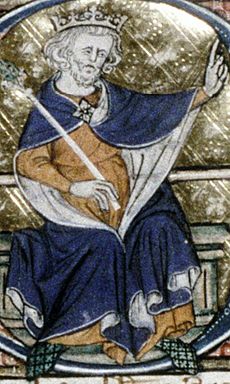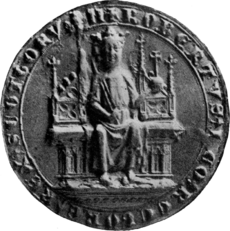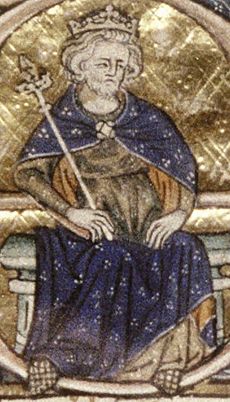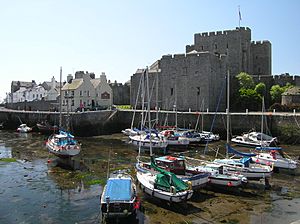Dungal MacDouall facts for kids
Quick facts for kids
Dungal MacDouall
|
|
|---|---|

Dungal's name as it appears on folio 50r of British Library Cotton Julius A VII (the Chronicle of Mann): "Dungalli Mac Dowyl".
|
|
| Successor | Duncan MacDouall |
| Noble family | MacDouall family |
| Spouse(s) | Matilda, Margaret |
Dungal MacDouall (died before 1327/1328) was a Scottish nobleman from the 1300s. He was a strong opponent of Robert I, King of Scotland during the First War of Scottish Independence. Edward I, King of England made him a knight because of his help to the English king. Dungal was a close friend and possibly a relative of John MacDougall, Lord of Argyll. He received land in England and Ireland after losing his own lands in Scotland. During his time, Dungal was in charge of Dumfries Castle and Rushen Castle. He was even called "Captain of the army of Galloway." Dungal had a large family, and his son, Duncan, took over after him.
Contents
The MacDouall Family and Their Role
Dungal was the leader of the MacDouall family, a very important group in Galloway, Scotland. Their exact lands are not clear, but they were likely in an area called Wigtownshire.
In 1303, during a summer campaign by English forces, Robert Bruce VII, Earl of Carrick was asked to gather two thousand men from different parts of Scotland. Dungal MacDouall and Gibbon MacCann were also asked to gather two thousand men from Galloway.
In 1306, Robert Bruce claimed the Scottish throne. He had an argument with his rival, John Comyn of Badenoch, and Comyn was killed.
Like other powerful families in Galloway, such as the MacCanns and MacCullochs, the MacDoualls naturally opposed Robert Bruce. These families supported the English kings, Edward I and Edward II. Dungal handed over Robert's brothers, Alexander and Thomas, to King Edward. This made Robert Bruce very angry. Even after Robert became king, families like the MacDoualls continued to fight against him from England.
Battles Against the Bruces

In January 1307, Dungal defeated a group of Robert Bruce's supporters who landed at Loch Ryan in Galloway. It's not known if this attack was just a raid or the start of a bigger plan.
According to an old record called the Chronicle of Lanercost, the invading force had eighteen ships. It was led by Robert Bruce's brothers, Thomas Bruce and Alexander Bruce, along with Reginald Crawford. Dungal, described as "a chief among the Gallovidians," defeated them. He had some of the leaders beheaded and sent their heads to King Edward I. Thomas, Alexander, and Reginald were also sent to the king and were executed.
Another old book, Flores historiarum, tells a similar story. It also mentions Bruce's brothers and Reginald, but names one of the leaders as Malcolm Makaill.
The Chronicle of Lanercost says that Thomas, Alexander, and Reginald were executed on February 17. Because of his help to the English king, Dungal was made a knight by Edward I on March 26, 1307. Dungal also received £40 for capturing Bruce's brothers. King Edward I also gave Dungal land and an important job in Ayr.

In 1308, King Robert sent his remaining brother, Sir Edward Bruce, to Galloway. They wanted revenge on Dungal MacDouall for the loss of Robert's two brothers. Sir Edward and James Douglas attacked the MacDoualls and their English allies at night. They drove them out of Galloway. After this success, King Robert made his brother, Edward, the Lord of Galloway.
King Edward I was very harsh. He executed Robert Bruce's brothers and supporters. One of Robert's brothers, Alexander, was a priest. Edward I disliked the idea of Scotland being free. He also saw Bruce's killing of John Comyn as a terrible act.
In March 1307, Dungal asked King Edward I to allow his younger brother, also named Dungal, to marry the daughter of Hugh Chaumpaigne. Dungal also successfully asked for a pardon for Elias Vaux, who was involved in a killing.
Protecting Galloway

Dungal's actions show how the people of Galloway stood against Robert Bruce. Because of this, Robert Bruce sent his brother, Edward, to lead a campaign against Galloway. Edward later became the Lord of Galloway. This campaign likely started after King Edward I died in July 1307.
In September, King Edward II ordered that people from Galloway who had fled should be allowed to feed their animals in Inglewood Forest. Five days later, Edward II told John, Earl of Richmond, to stop the Bruce campaign in Galloway. This was because English supporters like John St John, Dungal, and Donald MacCann had told the English king about the serious situation there.
In mid-1308, King Robert I got his revenge on MacDouall. His brother, Sir Edward Bruce, took over Galloway. He forced Dungal and his family out of Scotland. This campaign is mentioned in several old records. The final battle in this campaign may have been fought near Buittle, by the River Dee.
One record says that a "Donald of the Isles" led a group of Gallovidians to the River Dee, where they were defeated by Edward Bruce. This "Donald" might have been Dungal himself, or perhaps Donald MacCann, who also supported the English.
Losing Lands and Gaining New Roles
After being forced out of Scotland, Dungal received protection from the English king in August 1308. He probably tried to get his lands back, but he didn't succeed. Months later, he was given an English estate called Temple-Cowton in Yorkshire to support his family. This record is the first time Dungal is called a knight. He was likely made a knight by the English. He was known to be "hated by the enemy" (the Scots) for his actions in Scotland.
Before 1308, the Temple-Cowton estate belonged to the Knights Templar. In 1312, the king ordered that the estate be given to Dungal's wife, Matilda, until Dungal could receive it himself.
Around 1310-1311, Dungal was made the commander of Dumfries Castle and also served as the Sheriff of Dumfries. On February 7, 1312, Dungal had to give up the castle to Robert Bruce's forces. Even though Dungal had captured and helped execute the Scottish king's brothers five years earlier, he was allowed to go into exile after surrendering the castle. The fall of Dumfries was part of Robert Bruce's effort to capture several castles in southwestern Scotland that were still resisting him.
In May, King Edward II ordered that Dumfries Castle be made stronger. In July, Dungal's brother, Fergus, was helping to supply the castle with weapons. Later that month, Dungal said he received some supplies. But in August, he complained to the English king that a lack of supplies from Carlisle had caused many of his men to leave.

After leaving Dumfries, Dungal was sent to the Isle of Man. An old record, the Chronicle of Mann, says that the Scottish king invaded the island on May 18, with help from his friend Angus Og Macdonald and his ships. They landed at Ramsey and surrounded Castle Rushen until Dungal was forced to surrender it on June 12. Dungal was likely put in charge of the castle after an earlier rebellion there. Robert Bruce probably used the confusion from this rebellion to launch his sea invasion.
After being forced out of Rushen, Dungal seems to have gone to Ireland. Records show that Robert Bruce sent ships to attack the Irish. It seems Robert continued his fight with Dungal from Dumfries and Rushen all the way to Ireland.
Later Life and Family
In July 1314, Dungal was sent from Carlisle to warn King Edward II in York about an upcoming attack by Robert Bruce on Carlisle.
In August 1316, Dungal's wife, Matilda, received a gift of £10 from Edward II. Dungal himself was supposed to get £20 each year. At some point, Dungal was ordered by the English king to serve in Ireland. He asked the king for specific lands in Ireland, called Leixlip, until he could get his Scottish lands back.
In 1319-1320, Dungal was granted £20 each year for his help to the English king.
A request from Dungal's son and heir, Duncan MacDouall, in 1347, says that Dungal lost £100 worth of Scottish lands because he supported Edward I and Edward II. This request also reveals that one of Dungal's brothers was killed during the war. This was because of the brothers' part in capturing and executing Robert Bruce's brothers. Dungal's oldest son was also killed fighting for the English at the Battle of Bannockburn. Duncan's request said that his father received £20 a year, and that Duncan and Dungal's six other sons now had no support. So, Duncan asked for his father's yearly payment to continue. The king's council thought it would be kind to help them. The names of Dungal's other sons are not known.
Dungal was very close to John MacDougall. For example, in July 1310, Dungal received 100 merks from John for his service to the English. Later, in 1315-1316, John, Dungal, and Duncan MacGodfrey received money and supplies from the English for their actions against the Scottish king in the Irish Sea area. Both Dungal and Duncan MacGodfrey were part of the Carlisle army after Edward Bruce was defeated in 1318. It is possible that Dungal thought of John MacDougall as a relative. John died in September 1317, and Dungal was in charge of his funeral. Dungal also handled John's will. In 1327, Dungal asked King Edward III for the rest of John's yearly payment to pay off John's debts.
Dungal himself died before January 1327-1328. At that time, his widow, Margaret, was confirmed to receive the lands that Dungal had been granted. Later, in February, Edward III excused Dungal's executors from paying debts on these lands because of Dungal's loyal service. Dungal was succeeded by his son, Duncan. Margaret died before January 1333-1334.
|

